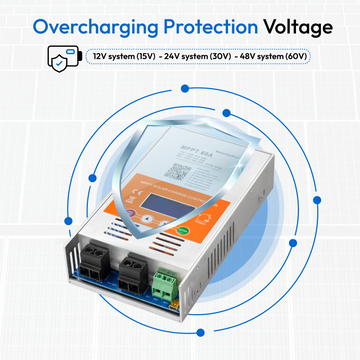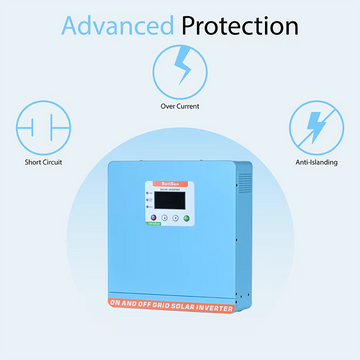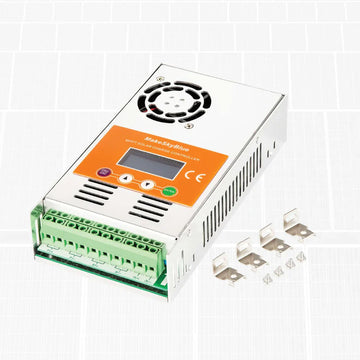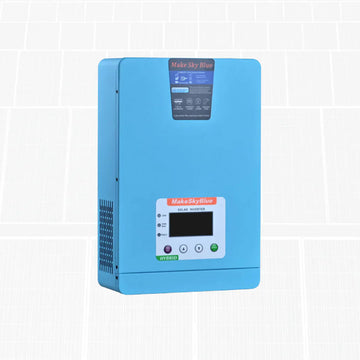A solar battery charge controller is a necessary item that is placed between your solar panels and the battery. This new gadget will regulate an electric current to avoid overcharging and give your battery bank the maximum power.
The solar charge controller market stood at USD 2.59 billion in 2024 and by 2030, the market will reach up to USD 7.14 billion. A solar battery charge controller manages the flow of electric power entering the batteries and leaving the solar panels by automatically regulating voltage and current. This guard prolongs the life of batteries as well as maximizing efficiency of the system. In its absence, the batteries will be damaged permanently due to high voltages.
How Does a Solar Battery Charge Controller Work?
The controller continuously monitors battery voltage and reduces charging current when voltage rises as solar panels generate power. Understanding the operational sequence explains system reliability through Detection Phase, Regulation Phase, Maintenance Phase, and Nighttime Protection stages. Modern controllers prevent battery overcharging and optimize functioning through advanced voltage regulation, ensuring batteries remain healthy for extended periods.
PWM vs MPPT Solar Battery Charge Controller Technology
PWM technology accounted for 45.7% of global revenue in 2024, while MPPT captured the remaining market share with superior performance. PWM controllers function as electronic switches reducing excess voltage through rapid cycles, working well for smaller systems but losing efficiency in larger installations. MPPT technology harvests up to 30% more energy by tracking maximum power points continuously, adjusting voltage and current dynamically based on changing light conditions.
PWM vs MPPT Solar Battery Charge Controller
|
Feature |
PWM Controller |
MPPT Controller |
|
Efficiency Rate |
70-85% |
90-98% |
|
Energy Harvest vs PWM |
Baseline |
+20-30% more energy |
|
Voltage Conversion |
Fixed ratio |
Dynamic adjustment |
|
Temperature Performance |
Fair |
Excellent |
|
Cold Weather Charging |
Limited capability |
Superior performance |
|
System Cost |
Lower initial investment |
Higher upfront cost |
|
Long-term Savings |
Moderate ROI |
Significant ROI |
|
Best Application |
Small systems, basic needs |
Medium to large systems |
|
Lithium Battery Support |
Limited |
Full compatibility |
|
Weather Adaptability |
Fair reliability |
Excellent adaptability |
Key Features of Modern Solar Battery Charge Controller
Modern controllers include temperature compensation adjusting parameters based on ambient conditions, preventing battery damage. WiFi connectivity enables remote monitoring through applications with data logging for analysis. Advanced controllers support lithium batteries with constant current and voltage phases, plus load control features for equipment automation.
MPPT Solar Battery Charge Controller Market Growth 2024-2025
The renewable energy sector experiences significant expansion with the solar charge controller industry assessed at USD 3.22 billion in 2025, projected to reach USD 18.14 billion by 2037. Off-grid solar installations provide reliable electricity to communities where grid expansion is cost-prohibitive, with recent funding supporting expansion in Africa. Asia-Pacific holds 56% global market share, driven by rapid industrial growth, rural electrification, and pro-renewable policies.
Why MPPT Solar Battery Charge Controller Outperforms PWM?
MPPT technology delivers superior results by translating greater solar panel voltage to lower battery voltage, allowing batteries to charge with less current and reducing resistive power losses. Energy recovery increases by 20-30% daily compared to PWM models, providing long-term cost savings that offset higher initial investment. MPPT controllers continuously track and adjust PV voltage to generate maximum power regardless of conditions, enabling operating efficiency increases with energy generated up to 30% more than PWM alternatives.
MakeSkyBlue Solar Battery Charge Controller Solutions
MakeSkyBlue specializes in advanced renewable energy products with BettSun 100A MPPT Solar Charge Controller for large systems and 60A, 30A options for medium and smaller installations. The series includes WiFi connectivity enabling real-time performance tracking through dedicated software with support for both lithium and lead-acid battery chemistries. 60A models accommodate 12V, 24V, and 48V systems with 24/7 customer support and flexible payment options for residential and commercial applications.
MakeSkyBlue MPPT Solar Battery Charge Controller Models
|
Specification |
30A MPPT WiFi |
60A MPPT WiFi |
100A MPPT WiFi |
|
Maximum Amperage |
30A |
60A |
100A |
|
Voltage Support |
12V, 24V, 48V |
12V, 24V, 48V |
12V, 24V, 36V, 48V |
|
Battery Compatibility |
Lead-acid, Lithium |
Lead-acid, Lithium |
Lead-acid, Lithium |
|
WiFi Monitoring |
Yes |
Yes |
Yes |
|
Temperature Sensor |
Built-in |
Built-in |
Built-in |
|
Cloud Connectivity |
Optional Box |
Optional Box |
Optional Box |
|
Ideal System Capacity |
Small to Medium |
Medium to Large |
Large Commercial |
|
BMS Activation |
PV Start ON Support |
PV Start ON Support |
PV Start ON Support |
|
Load Control |
Available |
Available |
Available |
|
Typical Use Case |
Residential RV |
Residential Hybrid |
Commercial Farm |
Installation and Setup Considerations
Select a location with adequate ventilation to prevent overheating and mount in dry environments protected from moisture and temperature extremes. Connection sequence matters significantly to prevent electrical surges, requiring proper grounding for safety. Configuration demands attention to battery specifications with correct absorption and float voltages. Testing the complete system before operation identifies potential issues, with regular maintenance involving quarterly terminal cleaning and connection inspections.
Maximizing Solar Battery Charge Controller Efficiency
Install solar panels facing the sun throughout the day and change angles based on the season to be able to get the maximum solar input. Ensure proper operating temperatures are always maintained because high temperatures minimise efficiency and reduce the life of the components. Avail the option of monitoring system performance weekly by use of WiFi where possible, and historical data indicated inefficiencies and seasonal trends. Healthy batteries charge more effectively and completely due to a well-maintained battery.
Conclusion
Solar battery charge controllers are essential for reliable system performance and longevity. Quality equipment ensures maximum efficiency and battery longevity. MPPT technology provides superior results compared to PWM alternatives through long-term savings and better performance.
MakeSkyBlue offers solutions from 30A to 100A units with WiFi monitoring for residential and commercial applications. Choosing appropriate capacity and battery compatibility ensures years of successful operation.
Frequently Asked Questions
What happens if I don't use a solar battery charge controller?
Batteries face severe overcharging damage, reducing lifespan dramatically and creating safety hazards.
Can different solar battery charge controller types work with lithium batteries?
Modern MPPT controllers support lithium with proper configuration. Always verify compatibility before installation.
How often requires solar battery charge controller maintenance?
Clean terminals quarterly and inspect connections. Annual professional inspection ensures proper function.
What size solar battery charge controller is needed?
Select a controller with 20-30% safety margin above your system's total amperage. A 60A unit suits 45-50 ampere systems.
Does a solar battery charge controller work at night
Yes, it continues operating after sunset. Moreover, it prevents reverse current flow from batteries back toward panels. Additionally, this protects your system during low-light conditions.




